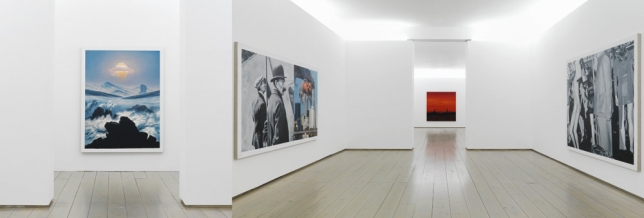01.09. – 22.10.07
Shi Xinning
“Polyphony”
Solo exhibition at Arndt & Partner, Berlin
PRESS RELEASE
Arndt & Partner is pleased to present the first solo show of the Beijing-based artist Shi Xinning in Europe.
Among the genres of contemporary Chinese art, none is more deeply ingrained in the visual memory of the West than that of Mao Pop. The way to this state of affairs was paved by adaptations of Mao portraits by Andy Warhol and Gerhard Richter. As early as the first officially sanctioned exhibition of contemporary Chinese art in China's National Art Gallery in Beijing (China/Avant-Garde, February 1989), Wang Guangyi's portrait of Mao Tse-tung - overlaid with a grid of red paint - proved controversial. Then came artists such as Xue Song, who reduced Mao to a mere contoured outline, and Yu Youhan, who depoliticizes propaganda images by embellishing them with folksy floral motifs.
The Beijing-based painter Shi Xinning explicitly distances himself from this tradition. The son of an officer in the People's Liberation Army, he was born in 1969 in the northeastern province of Liaoning. In a series of oil paintings on canvas that he has been working on since 2000, an idealized energetic Mao is seen in the company of Hollywood stars, artists and political figures. But these works do not present retrogressive arguments. Instead they tell fictitious or, as he calls them, utopian stories. Shi Xinning compares his work as an artist with that of a film director. He often uses newspaper images as the basis for his paintings. In keeping with the visual qualities of these media images, he employs barely visible brushwork and a washed out, muted palate. Shi Xinning then develops his narratives, substituting objects or people in the original with his own selections, adding elements that were not there in the original, and adjusts the lighting of the scenes. "I almost always work with a staging of completely incompatible props and scenery. For example, Mao views a Duchamp exhibition in China - something that never took place. Or I place a curved steel sculpture by Richard Serra in Tiananmen Square - facing Mao's famous portrait at the entrance to the Forbidden City. Or I arrange a meeting between a Mao statue and New York's Statue of Liberty. […] I am not interested in Mao Tse-tung as a real person. Today, Mao is still an icon in China. He is omnipresent; he defined my childhood and the lives of my parents. I never show him in the real context of the 60s or 70s. I present him as a visual memory."
History is either a three- to five-thousand-year continuum that can enable individuals to define their place in the present, or something that can be willfully revised to produce formulas that summarize the deeds of Mao as: "70"> good, 30"> bad" (Deng Xiaoping). Both positions coexist peacefully in China. As the critical study of history has not really been established there, a further role for contemporary art in China is that of a mediator between these two extremes. Images by artists such as Shi Xinning scrutinize the pride and reverence with which many people in China still regard Chairman Mao today - despite all the misery that the Cultural Revolution brought to the Chinese people, not to mention Mao's hostility towards intellectuals and the arts. Such heroism focuses on the Long March, the establishment of a new national order, the valorization of the rural poor, and the tireless forging of a collective Chinese spirit. Mao's mistakes are eclipsed by his achievements. They are "the errors of a great proletarian leader," according to a 1981 Central Committee resolution "on some questions concerning the history of our party."
Shi Xinning's relationship to Mao is ambivalent - a fact he is acutely aware of. His images represent this tension in the form of paradoxes: Mao meets the Beatles, admires Christo's wrapped Reichstag, and - in a gesture that is hard to top - attends a nude performance by contemporary Chinese artists. If Shi Xinning's art is utopian, this is not because it illustrates a desire for the reconciliation of antagonistic value systems. On the contrary, the artist's ideals are acted out on a purely aesthetic level in nonexistent moments of history.
Ulrike Münter (excerpt from her essay published in the catalogue accompanying the exhibition)
